#eichhornia
Text

Disobedient Beauties
Watercolor On Artboard
2023, 12"x 16"
Common Water Hyacinth, Eichhornia crassipes
Sodalite and Kyanite
#art#nature#flowers#plants#floral#painting#minimalism#watercolor#artists on tumblr#water#blue#water hyacinth#common water hyacinths#eichhornia#blue floral#water plants#artwork#botany#plant#botanical#artworks#contemporary art#cottagecore#cottagecore aesthetic
331 notes
·
View notes
Photo

Rare Cold Hardy Mini Water Hyacinth Eichhornia Hybrid
4 notes
·
View notes
Text
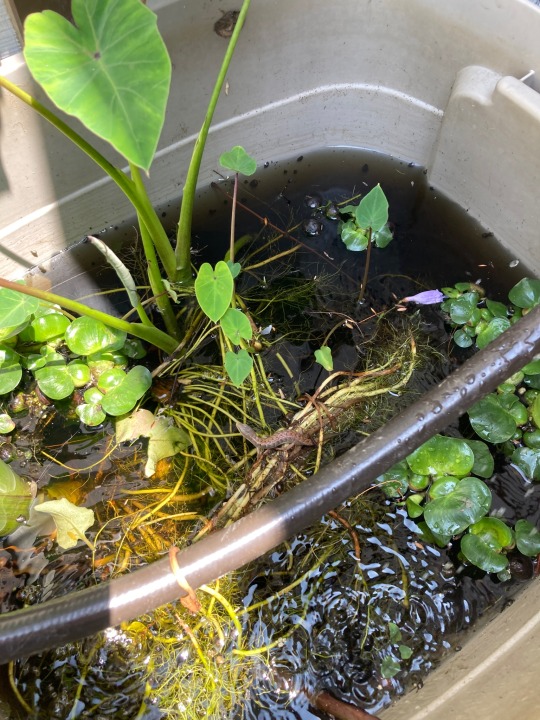
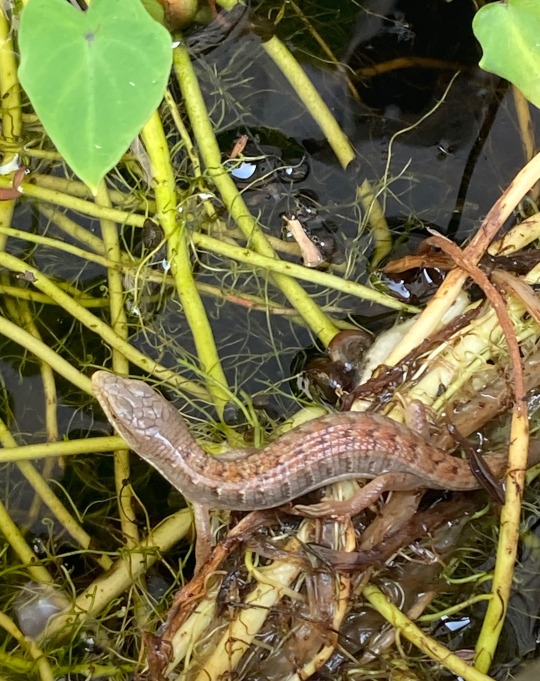

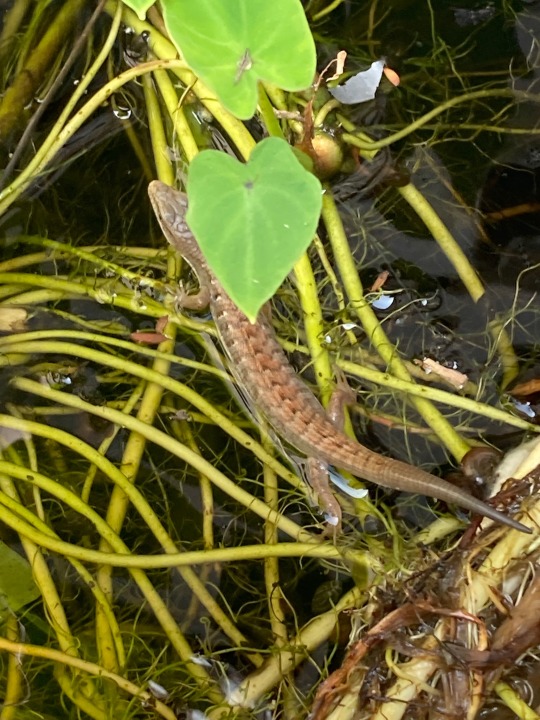

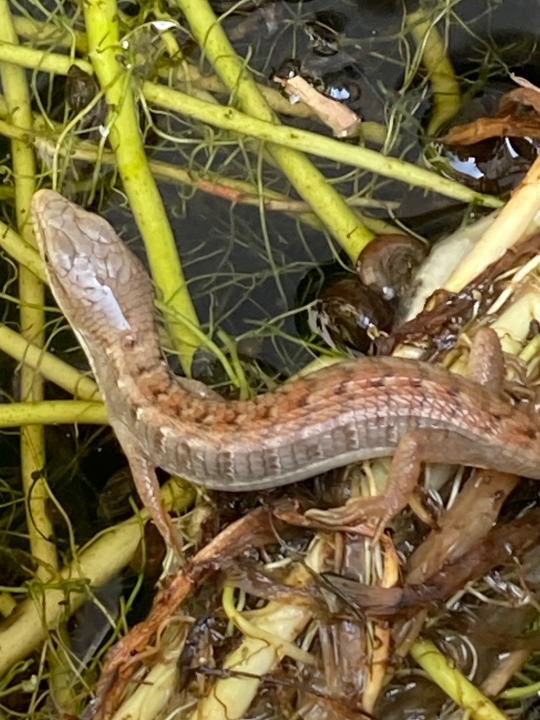
#alligator lizard#elgaria#lizards#reptiles#urban wildlife#taro#arrowroot#colocasia#water hyacinth#eichhornia#aquatic plants#van nuys
1 note
·
View note
Text

Título: Jacintos de agua II
Técnica: Acrílico, Papel Craft (Collage)/Tela
Formato: 1.10cm x 70 cm
#art#colorido#colorful#color lovers#traditional art#flowers#lirios acuatico#fragility#tiempo congelado#pintura mexicana#pintura#pintura acrilica#acrylic painting#Liliopsida#Eichhornia crassipes#pintura contemporanea#mexican artist#female artists#artists on tumblr#ilustracion#ilustration#collage#arte lineal#dibujo#drawn#boy#peces#sueño#naranja y amarillo#orange and yellow
1 note
·
View note
Text
inspired by @starfoozle's poll - happy national invasive species week!
visual supplement below (and some help narrowing down the list) provided by @obeetlebeetle

#polls#invasive species#everglades#i said i'd do it and i did!!!!!#capital stuff#honorable mention to australian pine + nile monitor lizard + black and white tegu. all cool guys but not cool enough to make top 9
560 notes
·
View notes
Photo
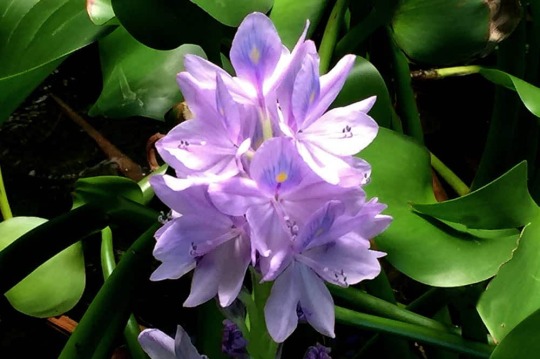
Water hyacinth, an invasive plant with ecological virtues
The water hyacinth or camalote (Eichhornia crassipes is one of the most beautiful aquatic plants with its purplish blue flowers and very green foliage. But its stems form dense floating mats that block light and capture the oxygen needed by fish. Also, despite the beauty of its flower, this plant is considered the most destructive weed in the world.
The shiny, spoon-shaped leaves are arranged in rosettes. They are thick, waxy and lustrous, and stand well above the surface of the water. Large flower stalks each bear 8 to 15 flowers gathered in a spike, like hyacinths. These funnel-shaped flowers consist of six purplish-blue petals, with the top petal showing a yellow spot. The capsule-shaped fruit can contain up to 450 seeds. From the bulbous and spongy rhizome start numerous purplish black and feathery roots which can measure up to 3 m in length.
This invasive plant has ecological virtues. Water hyacinth is indeed a biological filter that captures CO2, promotes photosynthesis, but, above all, has the ability to absorb heavy metals and rid the aquatic environment of pollutants. It is also an excellent source of biomass.
11 notes
·
View notes
Text
you know what would be silly? if i was tired and just went ahead and posted the bookshop fic right now... SO ANYWAY HERE IT IS
R&R's Fictions and Foliage: Chapter 1: Eichhornia
“It’s not fair! He’s so pretty,” Regulus groans.
“I’m sure he is.”
“I’m so gay.”
“I know.”
#fic: r&r's fictions and foliage#jegulus#jegulus fanficiton#regulus black#james potter#marauders#marauders era#marauders fanfiction#ao3
6 notes
·
View notes
Text
Aguapé - Eichhornia crassipes - Planta aquática
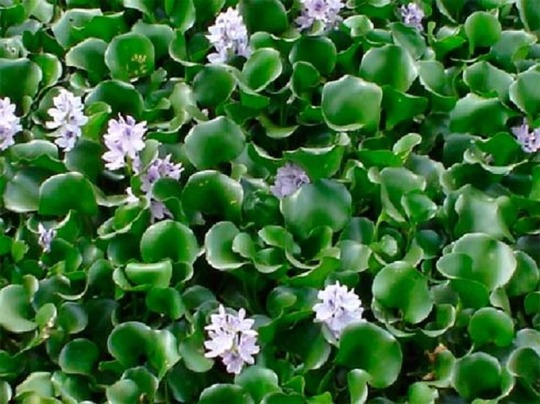
Nome Científico: Eichhornia crassipes
Nomes Populares: Aguapé, Baroneza, Camalote, Jacinto-d'água, Murumuru, Mururé, Pareci, Pavoa, Rainha-dos-lagos
Família: Pontederiaceae
Categoria: Plantas Aquáticas, Plantas Flutuantes
Clima: Equatorial, Subtropical, Tropical
Origem: América Central, América do Norte, América do Sul
Altura: 0.1 a 0.3 metros
Luminosidade: Sol Pleno
Ciclo de Vida: Perene
Sobre a Aguapé
O aguapé é uma planta aquática flutuante que se desenvolve muito bem nas regiões de clima quente seu desenvolvimento é acelerado quando não existem limitações nutricionais, como é o caso das águas das lagoas e represas que são poluídas por esgoto urbano e alguns tipos de efluentes industriais.
Planta aquática e flutuante o aguapé é muito ornamental. No entanto em algumas situações de superpopulação ela pode tornar-se um problema em lagos. De folhas redondas, grandes e brilhantes o aguapé multiplica-se rapidamente.
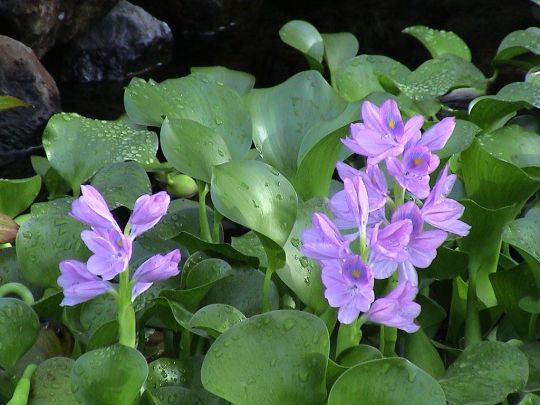
A inflorescência da Aguapé é composta de belas flores azuis arroxeadas assemelha-se a do jacinto
A poluição de maneira geral causa um enorme dano a cursos de água, um deles é a eutrofização que é o fenómeno pelo qual a água é enriquecida por nutrientes diversos, principalmente compostos fosforados e nitrogenados.
A Eichhornia crassipes é uma macrófita aquática que tem propriedades de auxiliar na redução dos nutrientes precursores desse desenvolvimento, portanto, possui uma considerável importância ecológica, reconhecida através de suas propriedades filtradoras, visto que reduz a proliferação de bactérias e vírus patogénicos e de outros microorganismos que consomem oxigénio do meio aquático.
A eficiência do aguapé Eichhornia crassipes como despoluidor biológico foi comprovada quando o mesmo apresentou crescimento acelerado em ambiente aquático eutrofizado, uma vez que este absorve os nutrientes presentes em excesso, os quais são indispensáveis ao seu desenvolvimento.
Tendo em vista os actuais problemas ambientais, referentes à escassez de água potável a nível mundial, a utilização desta espécie facilita o tratamento de lagoas de efluentes das indústrias, de forma económica e ecológica.
Read the full article
0 notes
Text

Water Fight
Watercolor on Artboard
2022, 12"x 16"
Common Water Hyacinth, Eichhornia crassipes
Amethyst
Private Collection
#artists on tumblr#flowers#floral#art#watercolor#painting#nature#minimalism#common water hyacinths#water hyacinth#eichhornia#amethyst#plants#plantblr#purple#purple floral#water#water plants#creatrs#naturecore#artwork
47 notes
·
View notes
Photo
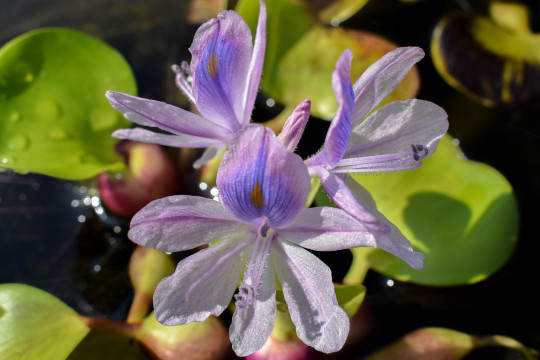
Water Hyacinths (Eichhornia crassipes)
1 note
·
View note
Text
WATER PLANT IN BANGLADESH

This article explores the importance of Water Plant in Bangladesh, the different types found in Bangladesh, their benefits, environmental and economic impacts, challenges in cultivation, government initiatives, and future prospects. By understanding the significance of water plants, we can appreciate their contribution to sustainable development in the country.
Introduction
Water plants are aquatic vegetation that grows in or near water bodies, such as ponds, lakes, rivers, and wetlands. These plants serve several essential functions, including oxygenation, filtration, and habitat creation. In Bangladesh, a country abundant in water resources, water plants hold great significance due to their various advantages and potential.
Importance of Water Plants
Water plants are vital for maintaining a balanced ecosystem. They act as oxygenators by releasing oxygen into the water during photosynthesis, supporting the survival of aquatic organisms. Additionally, water plants help filter pollutants, such as excess nutrients and sediments, improving water quality. They also provide shelter and breeding grounds for fish and other aquatic species.
Types of Water Plants
Various types of water plants thrive in the diverse aquatic habitats of Bangladesh. These plants can be classified into submerged, floating, and emergent categories. Submerged plants, such as Hydrilla and Vallisneria, grow entirely underwater. Floating plants, like Water Hyacinth and Duckweed, float on the water's surface. Emergent plants, including Lotus and Water Lily, have their roots submerged but their leaves and flowers are above the water.
Common Water Plants in Bangladesh
Bangladesh is home to a rich variety of water plants. Some common water plants found in the country include Water Hyacinth (Eichhornia crassipes), Water Lily (Nymphaea spp.), Lotus (Nelumbo nucifera), Duckweed (Lemna spp.), and Hydrilla (Hydrilla verticillata). These plants contribute significantly to the ecological balance and provide resources for various purposes.
Benefits of Water Plants
Water plants offer numerous benefits to both the environment and human activities. From an environmental perspective, they help prevent water pollution, control algae growth, and provide habitats for diverse aquatic organisms. Water plants also contribute to soil stabilization, preventing erosion along water bodies. Moreover, these plants possess aesthetic value, enhancing the beauty of natural landscapes and gardens.
#water filter#waterfilter#water filter price in bd#waterpurifier price in bd#water purifier#reverse osmosis water purifier#waterpurifierpriceinbd
0 notes
Text
Une équipe de chercheur·euses a évalué le coût des invasions qui aurait augmenté de 700 % en 40 ans et serait plus important que les tempêtes, séismes, cyclones, sécheresses et incendies
See on Scoop.it - EntomoNews
Une nouvelle étude souligne le manque d’investissements pour prévenir les invasions biologiques, dont les conséquences sont pourtant désastreuses.
Les espèces invasives, un fléau aussi coûteux que les inondations ou les tremblements de terre
Par Perrine Mouterde
Publié le 18 avril 2023
"Elles sont moins spectaculaires qu’un tremblement de terre, moins brutales qu’une tempête. Les espèces exotiques envahissantes peuvent pourtant avoir des conséquences tout aussi importantes que les catastrophes naturelles : selon une étude publiée dans le numéro d’avril-mai de Perspectives in Ecology and Conservation, les invasions biologiques ont provoqué, au cours des quarante dernières années, des pertes financières équivalentes à celles causées par les séismes, les cyclones, les sécheresses ou les incendies."
(...)
[Image] Lors d’une opération de nettoyage du canal du Centre, près de Digoin (Saône-et-Loire), le 10 mars 2023. Un faucardeur-moissonneur arrache les plantes envahissantes, notamment le myriophylle hétérophylle. LACHAS D/ANDBZ/ABACA
-------
NDÉ
L'étude
Biological invasions are as costly as natural hazards - Anna J. Turbelin et al. - Perspectives in Ecology and Conservation, 29.03.2023 https://www.sciencedirect.com/science/article/pii/S2530064423000214?via%3Dihub
Highlights
• Damage costs from biological invasions and natural hazards are of similar magnitude.
• Global biological invasion costs increased by 702% from 1980–1999 to 2000–2019.
• Invasion costs increased faster than natural hazard damages over time (1980–2019).
[Image] Pictures of natural hazards impacts and invasive alien species.
A) Wildfire, South Africa, 2014
B) Flood, Bingley UK, 2015
C) Earthquake, 2021 and
D) Invasive water hyacinth clogging waterways (Eichhornia crassipes) Jatiluhur, Purwakarta Regency, West Java, Indonesia, 2021.
Pictures by A) Anna Turbelin, B) Chris Gallagher on Unsplash, C) Dave Goudreau on Unsplash, and D) Eka P. Amdela on Unsplash.
Bernadette Cassel's insight:
« Une équipe autour de Franck Courchamp a évalué le coût des invasions qui aurait augmenté de 700% en 40 ans et serait plus important que les tempêtes, séismes, cyclones, sécheresses et incendies. Pour les fourmis ils citent l'arrivée de la fourmi électrique à Toulon, et le problème de la fourmi de feu aux USA. »
Alain Lenoir
Fourmis invasives
http://www.dictionnaire-amoureux-des-fourmis.fr/F/Fourmis%20invasives/Fourmis%20invasives.htm
Sur le même sujet
Les invasions biologiques, aussi coûteuses que des catastrophes naturelles - De www.cnrs.fr - 16 avril, 13:11
0 notes
Text
Nanoplastics threaten plants' ability to clean up industrial waste
You can listen to this page as an audio file.
There’s a lot of research on constructing artificial wetlands to clean up industrial waste. Now a new study published in the Journal of Hazardous Materials conducted by Huawei Jia and colleagues in China has revealed that the aquatic plant Pontederia crassipes, (also known as Eichhornia crassipes or Water Hyacinth), often used to remove contaminants…

View On WordPress
0 notes
Photo

….Eichhornia crassipes..Common water hyacinth…🤪..แถวบ้านเรียกผักตบชวา..😜😝 https://www.instagram.com/p/CpmPC8Dv4r0/?igshid=NGJjMDIxMWI=
0 notes
Text
Buy Finger Millet from No -1 Organic Farm.
A sequence of experiments with processing and brewing adopted. The authors carried out experiments in the Sudan with the usage of water hyacinth as a mulch to suppress nutsedge, Cyperus rotundus. The outcomes of the sector tests showed conclusively that water hyacinth is a invaluable manure either in the rotted state or as ash on laterite soils of the previous alluvium in Bengal. There is a few indication that soil microflora may be adversely influenced by improper aquatic weed addition to soils. Hentges, 1976 Aquatic weeds – eradicate or cultivate? In a general evaluation of the utilization of aquatic weeds the authors state: “The easiest and least costly conversion which may be accomplished is merely to compost the aquatic plants. There must be more deal with the modification of current processing machines to make sure the conversion of millet seeds into flour. Suitable compost has been produced, though plant nitrogen conversion to nitrate is not ideal.

Basak tabulates the analyses of water hyacinth compost in contrast with town compost and farmyard manure. He advocates the making of water hyacinth compost, which he says is “four occasions richer than farmyard manure and is less than the standard worth of the latter.” He considers that the place labour is low cost mechanical harvesting is pointless and that the worth of the compost will more than pay for the associated fee of making it. He rejects this due to the lack of worthwhile nitrogen and natural matter, the labour and problem of drying the plant, particularly in wet weather, and the difficulty of storing and bagging the ash. Application of natural manures additionally showed constructive impact on productivity of finger millet-based mostly intercropping system. The typical iron degree in pearl millet-based meal was 8.2 mg/a hundred g while it was 5.6 mg/a hundred g in teff bread. After burning, the ash residues of unpolluted water hyacinth (unmixed with earth) have been discovered to contain as much as 35% of potash (K2O), and an average determine for the Dacca district would seem to be over 25%. The ash is therefore a number of times richer in potash than bizarre wood ashes. Buy Organic Finger Millet Online.
In Bengal water hyacinth comprises appreciable stores of plant meals of which potash is the chief constituent. The author begins by discussing the burning of water hyacinth to ash for fertilizer use in Bengal. Day, F.W.F., 1918 Water hyacinth as a source of potash. Barnyard Millet is a high source of iron and fibre. Finger millet stores nicely as a result of it has small seeds. There existed a large and properly organised network of schools for imparting increased schooling and these colleges have been known by numerous names corresponding to agraharas, ghatikas, brahmapura or matha. A few of the various silts of the new alluvial tracts exhibit potash deficiency and there’s little doubt that hyacinth, both rotted or as ash, will prove equally valuable for them. The writer states that water hyacinth ash has a business worth as a base for fertilizers, particularly potash fertilizers. The topmost layer of water hyacinth was built up in the shape of a dome and the highest was plastered with cowdung and canal mud to forestall any subsequent intrusion of rain water into compost heaps. Instead, semi-strong cowdung was added and the surplus water sticking to plants diluted cowdung in the layer beneath and in course of draining away effected thorough mixing with the water hyacinth layer underneath.
The author describes the manurial value of water hyacinth especially in regard to its potash content material, which is particularly excessive in the stalks. The ash has extra worth for fertilizer than other preparations of water hyacinth. Finlow, R.S. and K. McLean, 1917 Water hyacinth and its worth as a fertilizer. Abdel Hafeez, 1969 Some points of utilization of water hyacinth (Eichhornia crassipes). The papers that follow talk about all these aspects of the use of aquatic plants for crop improvement. Boyd, C.E., 1974 7. Utilization of aquatic plants. Additionally the soil is also able to hold more nutrients within the rooting zone and launch them when the plants need them. It was tough to have dry pits, significantly within the rainy season, attributable to excessive rainfall and subsoil water-table in Bengal and the compost charged pits had been inclined to holding outdoors water to delay decomposition and trigger leaching of soluble nutrients. Other plant nutrients within the ash are of negligible importance.
1 note
·
View note
Text
GNR apreende 220 plantas de espécies invasoras em Lousada
A GNR apreendeu 220 plantas de espécies invasoras, o que constitui uma contraordenação ambiental muito grave, e identificou um homem de 36 anos, no concelho de Lousada, foi hoje anunciado.
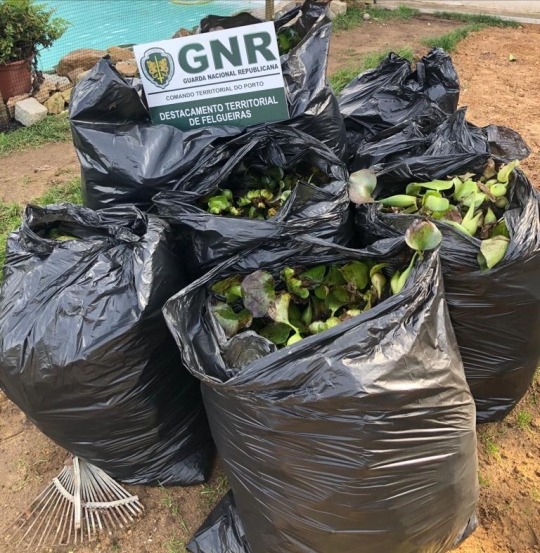
Em comunicado, a GNR referiu que, no âmbito de uma ação de fiscalização, os militares detetaram numa habitação na freguesia de Torno, no concelho de Lousada, 200 unidades de jacintos-de-Água (eichhornia crassipes), 20 unidades de elódea-densa e egeria-densa, e cerca de dois metros quadrados de salvinia-molesta, todas constantes na Lista Nacional de Espécies Invasoras.
Segundo a GNR, a compra, venda, oferta de venda, cultivo, criação ou comércio como planta ornamental ou animal de companhia de espécimes de espécies incluídas na Lista Nacional de Espécies Invasoras constitui uma contraordenação ambiental muito grave, punível com uma coima de 10 mil a 100 mil euros, em caso de negligência, e de 20 mil a 200 mil euros, em caso de dolo.
"As plantas foram de imediato apreendidas, ao abrigo da legislação aplicável ao controlo, à detenção, à introdução na natureza e ao repovoamento de espécies exóticas, e prevenção e gestão da introdução e propagação de espécies exóticas invasoras", acrescentou a GNR.
Durante a ação policial foi identificado um homem, de 36 anos, detentor das espécies invasoras e elaborado um auto de contraordenação, remetido ao Instituto da Conservação da Natureza e das Florestas (ICNF).
0 notes